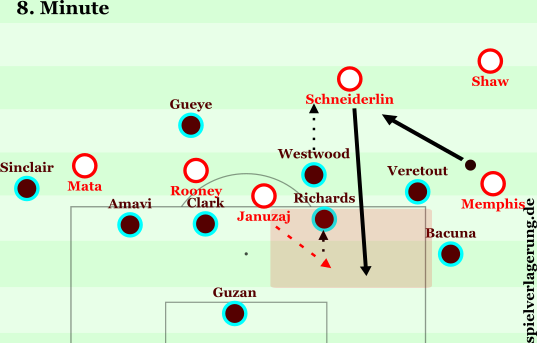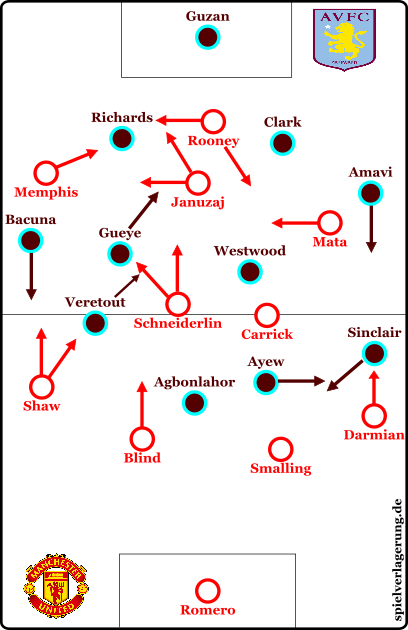Aston Villa – Manchester United 0:1
Premier League on a Friday. No more injuries, or reasons for not reaching latter stages, for English teams in the Champions League! (Well, maybe.)
Poor central connections for United
United began with one change in personnel (Januzaj for Young) and one role change from their first game (Memphis moves to the left, Januzaj takes over as the attacking midfielder). When United had the ball, they were mostly stable in building – bar some situations were Westwood and Gueye would block passing options to the United central midfielders, and pressure was applied by the Villa front two. The orientated their attacks mostly in the left halfspace and left flank – where they had the best connections. However, when looking to progress centrally or on the right they had poor connections. This was a result of various factors: positioning Memphis and Mata on the flanks early on leaves only Rooney and Januzaj the only forward options in central areas; some poor positioning and decision making of Schneiderlin, where he would either not be connected to the two forward players, or would make a line-breaking run off the ball which was poorly timed and isolated the players on the ball.
Exposing the left
One area United were successful and well connected was on the left, where Blind would occasionally join midfield from the back, Shaw would support play well (along with runs with the ball), and Memphis was positioned well to support Januzaj. The closer connections of the attacking players allowed a much greater dynamic for United, and allowed them to expose some weaknesses that Villa have. One of these is the poor connection between Richards and Bacuna, where they open the channel between them and no midfield player moving to cover the opened space. This hints at a rather instinctive and individual way of looking at defending. A problem of not looking at defending as a chain? Or a lack of value for halfspaces, in general, in English football? Or both?

Januzaj exposing the open channel between Richards and Bacuna. This area was exposed on a few occasions – due to the poor connection between the two defenders – and similar movements later resulted in the United goal.
This poor connection wasn’t just a one off, either. On various occasions United exploited this space. One resulted in the only goal of the game, and another in the second half – after a fantastic diagonal pass from Mata – created a clear chance for Memphis.
The role of Mata
Due to the positional structure of the United players with the ball, it was difficult for Mata to be influential on the right of the pitch, and was limited to occasionally dropping deep for the ball to help with building play, and rare opportunities to play depth diagonals, over the top, to Memphis. When he did move from the right to the middle and the left to overload, he became much more influential. Although he didn’t get the chance to move and overload other zones often, he managed to provide the pass which resulted in the goal – and would be far more influential, and useful, for United if he had a role with more freedom to move when the team are in possession of the ball.
Villa with asymmetry in their 442 with the ball
With the ball, Villa had a stable – yet non-progressive – buildup. Ayew acts as the second striker to Agbonlahor, with Sinclair on the left flank and Veretout moving central to connect and rotate with the Westwood and Gueye. Bacuna is high on the right flank in the vacated space, with Amavi in a supporting role – waiting to overlap – on the left. Villa not only had problems when looking to progress and move the ball into higher areas, but they also had poor connections and positional structure when the did manage to find players between lines. For example, when looking to progress up the left, Sinclair would move into the halfspace and look to come deep to receive. He was met with pressure by Darmian from behind and without any other passing options than to bounce the ball back to the player who had just passed him the ball. While this happened, Amavi would move higher on the left flank and then look to receive (Mata becoming ball-orientated upon the first pass, loses his man) but was isolated. However, he managed to show some good dribbling ability on some occasions, where he would move forward with the ball and go down the outside and cross.
When looking to progress centrally, Villa didn’t have options to play forward due to the positioning of the United midfielders (blocking passing lanes) and the distances between the front two and the player on the ball. Long balls over the top showed some promise, with space in-front of the dropping defensive line of United – with the midfield high to block vertical balls along the floor – but a combination of the inability to win the first ball, along with the lack of support near the long-ball target in order to compete for the second ball, prevented this being a solution for them.
Finally, on the right Villa didn’t have any options high early on, but did manage to find some combinations between the advancing Richards (forced, due to the United pressing in-between positions, to move forward with central passing options blocked), central midfielders and the progressive Bacuna on the right. In these situations they actually caused some co-ordination problems in United’s defensive structure, with Memphis leaving Bacuna free on the right – forcing Shaw to press him high up the pitch. At times it wasn’t possible for Shaw to cover for Memphis in these situations, as he would be pressing Veretout in midfield. Luckily for United, the excellent Daley Bilnd covered Shaw when he was exposed, and dealt with any danger successfully.
Introduction of Herrera and Schweinsteiger
Herrera and Schweinsteiger changed the dynamic of United in possession. Herrera was far more active that Januzaj in coming deeper for the ball (Januzaj would look to use good body position to resist pressure and then either pass the ball or draw a foul, but wasn’t efficient in this match) and looking for quick and intelligent combinations. Mata also become more prominent centrally upon the change.
Schweinsteiger came on in a much more direct possession role than Carrick. This, however, could be to do with the increase in forward passing options when he was on the pitch, compared to the situations Carrick was in with the ball in the first half. Overall, they had a much greater dynamic in their ball possession after the two changes.

4 Kommentare Alle anzeigen
Greg Paskow September 2, 2015 um 6:39 pm
Time well tell if two of the players Villa manager Tim Sherwood signed to replace him – Jordan Ayew and Rudy Gestede – can fill the powerful Belgium international s boots in attack. The boys gave everything for the cause but we didn t carry enough attacking threat, Sherwood said.
Brian August 17, 2015 um 3:05 am
Nice article. Your writing has become very valuable to me as I learn more about the game.
Pavlos August 16, 2015 um 6:28 pm
Nice article, keep the good job!!
Yiannis August 16, 2015 um 2:08 am
Another quality review mate keep it up